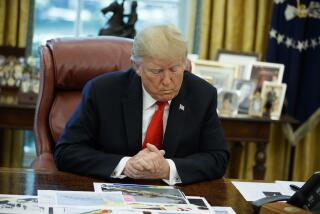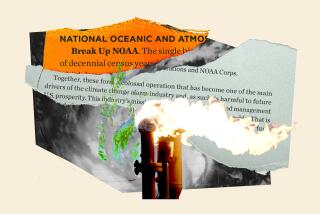U.S. Speeds Plan to Avert Ozone Harm : Environment: Bush says nation will phase out many chemicals that damage atmosphere by end of 1995. He urges other countries to do the same.
- Share via
WASHINGTON — President Bush, alarmed by reports of rapid ozone depletion over heavily populated regions of the Northern Hemisphere, Tuesday accelerated plans to phase out damaging chemicals and called on other nations to join the effort.
He said the United States will halt production of ozone-damaging chlorofluorocarbons, or CFCs, and most other substances that deplete the protective ozone layer by Dec. 31, 1995, rather than by the year 2000--the deadline set by an international agreement known as the Montreal Protocol.
He also said that the United States will reexamine its schedule for phasing out another family of ozone damaging chemicals, known as HCFCs.
His action, announced in a statement issued by the White House, came a week after research by the National Aeronautics and Space Administration and the National Oceanic and Atmospheric Administration showed that circumstances are ripe for serious new damage to the protective layer of ozone in the stratosphere.
The potential damage has important health implications for millions of people. Ozone in the stratosphere helps shield the Earth from the destructive effects of ultraviolet radiation. Ozone thinning has been blamed for a rapidly rising incidence of skin cancer and eye cataracts around the world and is believed to suppress the human immune system.
Natural radiation that reaches the Earth because of ozone depletion also can damage plants and ocean plankton.
Bush’s decision was immediately hailed by both producers of industrial solvents and refrigerants and by environmentalists, many of whom called for additional measures.
“This is a clear case of better late than never,” said Michael Oppenheimer, senior scientist of the Environmental Defense Fund.
An industry group, the Alliance for Responsible CFC Policy, said that it expects U.S. producers--Allied-Signal, DuPont, Elf Atochem and LaRouch--to respond affirmatively. Allied Signal chairman Lawrence A. Bossidy called the President’s initiative “responsible and achievable.”
Coming as it did on the night before he officially declared his candidacy for reelection as President, the decision has important political implications. During his 1988 campaign, Bush promised “to lead the world to a new recognition of the importance of the environment.” But his Administration has been criticized for lagging behind its European partners on the issue of global warming.
Bush’s campaign strategists believe that the environment will be an important election issue and is an area in which one of the Democrats’ strongest candidates, Arkansas Gov. Bill Clinton, is perceived to be weak. Furthermore, environmental issues are seen as extremely important in California, a crucial state for Bush.
Development of an ozone hole over Antarctica has troubled scientists for years, but the issue has become one of mounting public and political concern with the recent revelation of ozone thinning over heavily populated regions of the world.
Disturbed by evidence of a northern ozone hole comparable to the long-studied hole in the south polar region, government scientists last week issued an interim report on findings by satellites and spy planes crossing the Arctic. The new evidence shows not only a huge vortex of cold air favorable to formation of an ozone hole but the highest levels of ozone-damaging chlorine and bromine compounds ever recorded in the stratosphere.
In the White House statement, the President called on countries that have not signed the 1987 Montreal Protocol mandating an end to CFC production to do so.
The treaty is to be updated next November and, even before disclosure of the new evidence by scientists last week, environmental groups had been pressing for accelerated phaseout of both CFCs and their chlorine-based substitutes.
Chlorofluorocarbons used in refrigerants, such as Freon, and in a variety of solvents produce chlorine and bromine compounds, which rise into the stratosphere and cause a breakup of ozone molecules. Bush was given authority in the Clean Air Act of 1990 to unilaterally accelerate the phaseout by the United States, but he had resisted demands by environmentalists and congressional Democrats to do so.
Last year, after the Environmental Protection Agency reported that ozone thinning over the mid-latitudes could lead to an additional 200,000 skin cancer deaths in the world over the next 50 years, the Senate Foreign Relations Committee adopted a resolution calling on the President to accelerate the phaseout.
Following the warning of a possible ozone hole over the Arctic last week, the Senate approved a similar measure offered by Sen. Albert Gore Jr. (D-Tenn.) on a 96-0 vote.
The White House said Tuesday that domestic production of the chemicals is now 40% below the targeted levels of the Montreal Protocol and 20% ahead of non-aerosol CFC production by European nations. Production is now only 46% of the levels of 1986, an indication, the President said, that the United States is still a leader in the drive for a phaseout.
Environmentalists nonetheless have pressed for the faster action, especially in controlling chlorine based CFC-substitutes called HCFCs and halons, which have long been used by firefighters. Bush called on producers to cut their 1992 output to half of 1986 levels, instead of the 80% permitted by the Montreal Protocol. He said that the United States also would re-examine the phaseout schedule for HCFCs and consider a possible phaseout of methyl bromide, which has been a continuing target of environmentalists.
Scientists’ investigation of the situation in the Arctic resumed this week with satellites and modified spy planes based in Bangor, Me. If a huge cold air mass, constantly changing size and shape as it travels over the Far North, persists until spring sunlight returns, the chances are stronger that an ozone hole could develop.
In any case, Harvard chemist James G. Anderson said last week, the evidence already collected has demonstrated that the Earth’s natural immune system “is weaker than we estimated before.”
More to Read
Sign up for Essential California
The most important California stories and recommendations in your inbox every morning.
You may occasionally receive promotional content from the Los Angeles Times.










